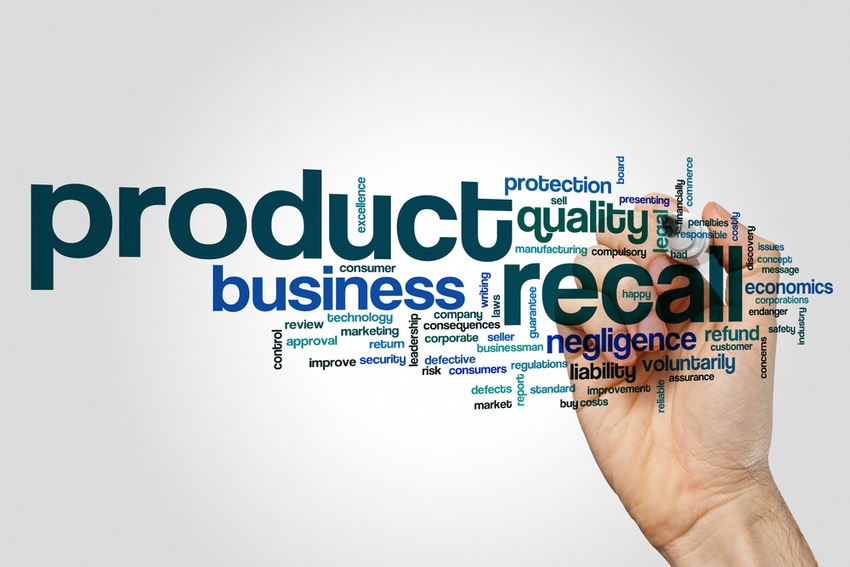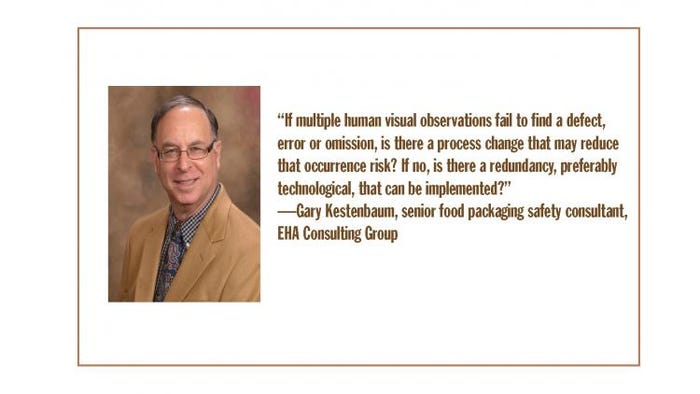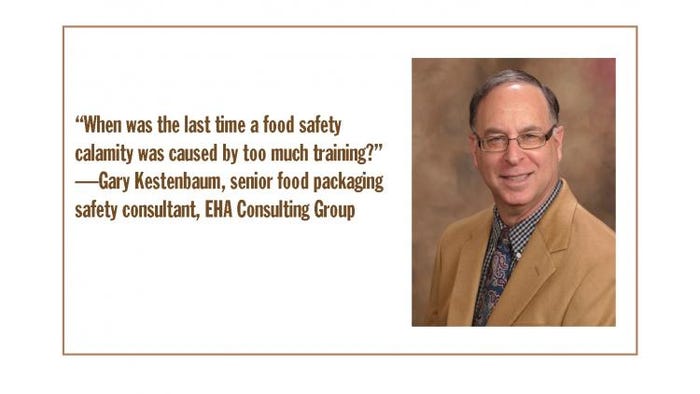How to avoid mislabeling of packaged foods
May 1, 2017

Food packaging safety expert Gary Kestenbaum offers advice on identification process objectives, defects, review and suggestions for process improvement related to product labeling and identification failures for food products. Is your company aware and prepared?
Misidentification, a critical process category in the food information supply chain, represents a huge, ongoing, unnecessary and eminently correctable calamity in the food industry. Misidentification includes defect types such as mislabeling, erroneous or missing copy, intermingling of materials, graphic design/printing errors, program entry errors and related defects. Allowing this category of defect to reach market occurs across the full spectrum of food and packaging products including raw materials, components, intermediates and consumer products.
Repetitive human safety-related error and omission defects are often facilitated by under-consideration as to severity and harm, under-resourcing in comparison to other safety-related risk types, or, simply, weaknesses in the process in need of review and redesign. Language in information-based “lessons learned” usually suggests that redundancies, process improvements, resource upgrades, continuous training and upgrades to the inspection process would have mitigated risks. Summaries often acknowledge funding and resource limits, offering the mea culpa “we targeted our resources on the safety of the food and then packaging/labeling defects flew under the radar.” Responsible organizations follow “lessons-learned” exercises with a process review, culminating with a rewiring in kind.
Understanding and classifying identification defects
There are many types of misidentification-related defects within the broader category which may ultimately impact the consumer, manufacturer and intermediate user. Some of the most common include:
Omitted details in written regulatory, food safety or product data documents, such as allowable and suggested usages and applications, regulatory references, etc.;
Errors or omissions on the package or container identification labels or printed copy (right product, wrong description or wrong product, right description);
Programming, configuration or data entry errors within labelers, bar code readers and related electronic hardware;
Specification or test data errors or omissions;
Product/item naming and identification similarity (appearance and identification graphics of two or more products are virtually exact);
Code-dating, manufacturing and related trace and recall data errors;
Design errors (graphic designer or programmer given the wrong details to add or misrepresented/misunderstood the details;
Unreadable alphanumeric characters due to substandard print quality or faults;
Intermingling of products in package such as when the inner package or product description doesn’t match outer package description; and
Shipper/unit load coding errors.
From a food safety standpoint, these defects are viewed similarly to those in the food (edibles) production chain. If one step is weak or prone to failure, the entire downstream process and users are exposed to risk and harm.

Clarifying objectives in policy
Begin the process by creating a policy or reviewing the language in your existing policy, describing the safety, quality and financial importance of the identification, labeling, copy, graphics and application/selection processes. Clarify the need for accuracy and explain the harm associated with failure to successfully accomplish those tasks.
Procedures connected to the policy should include clear chain of oversight, responsivity and execution. Steps should include creation of a committee or team, whose main objective is to review or, in the absence of existing, create job descriptions and qualifications for each person or group tasked with any process related to identification, labeling, selection, application or oversight of same, including:
Graphics and alphanumeric text development (hardware, configuration and data entry);
Technical content review(s) for errors, omissions or confusion risks;
Physical review processes including quality and accuracy;
Selection and application accuracy at the manufacturing or distribution level;
Review and oversight redundancies;
Ongoing 2nd or 3rd party process audits to validate effectiveness;
Team review of defects and actionable events; and
Training.
On face value, this may seem arduous or frivolous, but consider that eliminating one market withdrawal or recall would pay for multiple years of implementation costs.
Getting started
Assemble a cross-functional identification, information and communication safety team with representatives from procurement, scheduling, manufacturing operations, quality, packaging materials, graphic arts and shipping and receiving and human resources.
Provide team members with a map of the current process for choosing, creating, populating, printing approving, ordering, reviewing, receiving, storage and selection of labels, packaging and accompanying graphics and copy.
Discuss each step, assign objectives and expectations, list risks of improper performance and consequences of same, then discuss and create steps to control those risks (existing or non-existent and needed).
Summarize the outcomes and decisions in a table-format summary.
In other words, treat the process as what it is: a hazard to consumer safety, your productivity, profitability and reputation.
Next: Cautions and final thoughts

Cautions regarding identify job descriptions and qualifications
You wouldn’t assign the accountant to install a cartoner, nor would you ask the continuous improvement engineer to perform analytical chemistry. Why assign an underqualified, but available resource to make decisions and execute tasks which might result in a critical labeling or product communication failure? In the food industry, a series of expert sensory analysis protocols control process and qualify or disqualify judgements. Shouldn’t expert visual analysts or data entry technicians be subject to criteria for qualification and execution?
Don’t assign critical observation and analysis of copy, alphanumerics and label choice to an unqualified, overworked resource. Match job descriptions with skilled resources.
Create a table of identification, information and communication task responsibilities by group or step as identified by the cross-functional team.
Create a list of qualifications for each grouping using the list below, adapted to each unique challenge.
Responsibilities for product, material and packaging identification is broad. Qualifications based on expectations and requirements are likely more extensive than you considered.
“Identification professionals” competencies can be bucketed within three competency categories and may include some or all of the following:
Skills
Reading Comprehension and Technical Writing
Analytical Thinking (logic, reasoning, problem solving).
Listening (what colleagues are saying).
Effective Speaking (conveying information effectively).
Monitoring and Assessing and Evaluating Performance.
Judgment/Decision Making: assessing costs/benefits of effective corrective solutions.
Time and resource Management (one's own and colleagues or subordinates).
Applied Learning and speed of application.
Complex Problem Solving.
Coordination of actions and activities.
Influencing, Persuasion and Negotiating Skills.
Social Perceptiveness and Orientation, i.e. playing well with others.
Learning and Training - Selecting situation-appropriate methods and procedures.
Systems Analysis – Evaluating how changes in conditions, operations, and environment affects the outcome of the system or processes within.
Creative Design and Operations Analysis (connecting objectives with requirements).
Knowledge
English and other Languages: structure, spelling, content, meaning and grammar.
Functional Knowledge of Location and Industry Communication and Nomenclature.
Computers, Electronics and Technology including applications and configuration.
Clerical and Administrative skills.
Targeted Education and Training: Knowledge of process-specific principles.
Laws and Regulatory process knowledge relevance and how/where to access.
Corporate and facility History and Culture.
Trait
Attention to Detail and Care.
Dependability, reliability and Responsibility to obligation fulfillment.
Customer Service Orientation (always looking for ways to “satisfy the customer”).
Initiative to undertake responsibilities and challenges.
Adaptability/Flexibility to change.
Innovation, Creativity and Ideation to solve problems.
Achievement/Effort and Ownership
Persistence in the face of obstacles.
Stress Tolerance and Criticism Acceptance (dealing calmly and effectively with high stress situations).
Cooperation with and concern for others
Independence and execution with little or no supervision.
Integrity, honesty and ethics.
This is not to suggest that every person in the process chain needs to excel at all 35 competencies, but it is a “best practice” to consider which of the 35 are critical to the successful execution of each job, responsibility or task relating to information selection, creation, identification and selection.
Once each job objectives is matched to a description and qualifications:
3. Determine whether there is a resource currently assigned to each task or not.
4. Fill in names or functions and identify gaps.
5. Compare expectations against candidate qualifications.
6. Adjust obvious mismatches.

When qualified professionals are chosen and assigned, the resources must collaborate and consider (at least) policies and procedures of the end objectives, challenges of the individual facility, assignment of risk levels and expected frequencies, known or expected gaps, prior calamities and similar subject matter. Scheduled discussions and personal ownership should pave the way for practical upgrades and process improvements.
Executional considerations and final thoughts
There is no single set of protocols to use for Identification management. However, consideration of the previously listed competencies, or an adaptation of same, may help your organization in resetting objectives and then comparing the complexity, challenges, resourcing and other characteristics of those objectives against your existing process.
Ponder a few general concepts when creating processes to control critical product information and identification:
One set of eyes isn’t nearly enough. Often, neither is two.
If multiple human visual observations fail to find a defect, error or omission, is there a process change that may reduce that occurrence risk? If no, is there a redundancy, preferably technological, which can be implemented?
Is the identification, information and communication safety team tasked with analyzing monthly labels/copy etc. defects, assigning causes and ideating corrective actions?
When was the last time a food safety calamity was caused by too much training?
Reassess the process, redesign it, resource it, train it, implement it, validate it and audit it. Your facility will unquestionably benefit from the process improvements!
Gary Kestenbaum has 40 years’ experience in the food and packaging industries, 6 as a supplier with National Starch, 18 as a product developer with General/Kraft Foods and 15 as a packaging engineer and developer with Kraft. As senior food packaging safety consultant with EHA Consulting Group, Kestenbaum provides guidance on packaging safety and suitability-related projects for raw material manufacturers, converters and associated supporting professionals. He can be reached at [email protected] or 410-484-9133. The website is www.ehagroup.com.
About the Author(s)
You May Also Like




